
Modern Organocopper Chemistry
.pdf
318 10 Mechanisms of Copper-mediated Addition and Substitution Reactions
absorption spectroscopy [EXAFS (extended X-ray absorption fine structure spectroscopy) and XANES (X-ray absorption near edge structure spectroscopy)]. The latter category includes new developments in ab initio and density functional theories. In this chapter, recent progress on mechanisms of copper-mediated addition and substitution reactions is discussed in the context of the following topics:
(1)conventional mechanistic schemes for copper-mediated reactions,
(2)reaction pathways of organocopper-organometallic aggregates as analyzed through combination of theoretical and experimental data,
(3)mechanisms of copper-catalyzed reactions [45, 46].
Three important categories of copper reactions – conjugate addition, carbocupration, and alkylation – are discussed.
10.2
Conjugate Addition Reaction
Copper-mediated conjugate addition of alkyl anions to a; b-unsaturated carbonyl or related compounds (hereafter called enones) has long attracted chemists’ interest because of its synthetic importance and its obscure mechanism. The di culties inherent in the elucidation of the mechanisms of conjugate additions are due to the complexity of cluster structures of organocopper species. In the light of contrasting reports (one reporting conjugate addition to be slower in THF than in ether [47, 48], another reporting faster reaction in toluene, and further additional reports that, in toluene, 1,4-addition can be promoted over 1,2-addition in the presence of Me2O [49] and Me2S [50]), solvent e ects are a di cult subject to deal with. Nevertheless, there have been extensive experimental studies on the reaction mechanisms of conjugate addition.
10.2.1
Four-centered and Six-centered Mechanisms
Four-centered addition of RCu to an enone was widely discussed in the 1960s (Scheme 10.3a) [51–53], while discussions on six-centered transition states have continued until recent times (Scheme 10.3b) [54]. These mechanisms do not, however, explain the formation of E=Z mixtures of enolate stereoisomers [20, 55] and must now be considered obsolete.
Scheme 10.3. a) 1,2-Addition and b) 1,4-addition proposals.

10.2 Conjugate Addition Reaction 319
10.2.2
Single-electron Transfer Theorem
House pioneered synthetic and mechanistic studies of cuprate reactions in the 1970s. His papers proposed a mechanism (Scheme 10.4) that assumes a singleelectron transfer (SET) from the dimer, producing a CuIII intermediate [56, 57]. The SET/CuIII theorem had a strong following for many years. However, most of the experimental facts listed below, once considered to support the SET process, are now no longer accepted as evidence of SET. Only the CuIII hypothesis has survived the test of time.
Scheme 10.4. House’s 1,4-addition mechanism.
(1)E=Z isomerization of the olefinic part of an enone was once taken as evidence for reversible electron transfer. It was later reported, however, that this isomerization takes place even in the presence of LiI, a common component of the
Gilman cluster reagent (for example, Me2CuLi LiI) [58]. Such an isomerization is also possible through reversible generation of an advanced d-p copper/
enone complex along the reaction pathway [42, 59], and hence does not represent strong evidence for SET.
(2)Qualitative correlation of the apparent rate of 1,4-addition with the reduction potential of the enone was later proven to be only superficial, through quantitative kinetic studies by Krauss and Smith [60].
(3)b-Cyclopropyl a; b-unsaturated ketones such as the one shown below often give ring-opening products, which was taken as strong evidence for radical anion formation by SET. An elegant study by Casey and Cesa, using a deuteriumlabeled substrate, indicated stereospecificity in the cyclopropane ring-opening, which hence refutes the radical mechanism (Eq. 10.4) [61]. On the basis of a series of control experiments, Bertz reinterpreted the results in terms of CuIII intermediates formed by two-electron transfer [62].
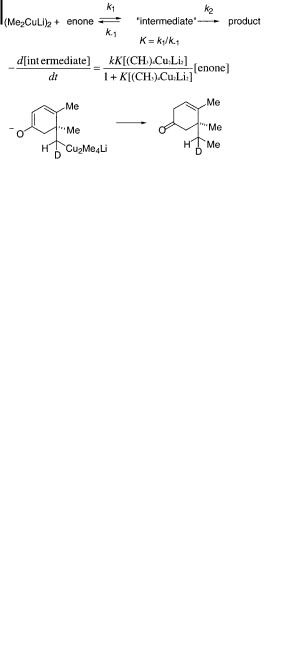
320 10 Mechanisms of Copper-mediated Addition and Substitution Reactions
ð10:4Þ
(4)ESR and CIDNP studies intended to detect the radical intermediates failed [63]. Conjugate addition of a vinylcuprate reagent to an enone takes place with retention of the vinyl geometry, indicating that no vinyl radical intermediate is involved [64, 65]. Kinetic isotope e ects and substituent e ects in cuprate addition to benzophenone indicate that CaC bond formation is rate-determining, which is not consistent with the involvement of a radical ion pair intermediate [66].
SET processes do not occur among moderately electrophilic olefinic acceptors, but are likely to be involved in highly electrophilic substrates. Some recent examples are the polyadditions of cuprate to fullerenes (Sect. 10.1.1). Fluorenone ketyl radical has been detected in a cuprate reaction of fluorenone [20]. Doubly activated olefins [67–69] and bromonaphthoquinone [70] also probably react through SET.
10.2.3
Kinetic and Spectroscopic Analysis of Intermediates
Conjugate additions to a; b-unsaturated ketones and esters are the most important cuprate reactions. Kinetic studies by Krauss and Smith on Me2CuLi and a variety of ketones revealed the following kinetic characteristics (Eq. 10.5), first order both in cuprate dimer and in the enone [60].
ð10:5Þ
This rate expression is consistent with the reaction scheme shown in Eq. 10.6, formulated on the basis of the Krauss–Smith paper. Thus, the initially formed cuprate dimer/enone complex with lithium/carbonyl and copper/olefin coordinations [71, 72] transforms into the product via an intermediate or intermediates. A lithium/ carbonyl complex also forms, but this is a dead-end intermediate. Though detailed
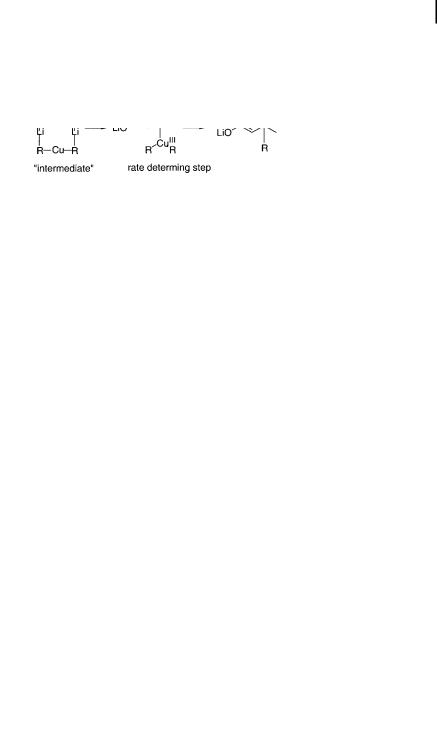
10.2 Conjugate Addition Reaction 321
structures of the intermediates were unknown for a long time, the essence of this scheme was supported by subsequent NMR and XANES spectroscopic studies and recent theoretical investigation. The key ‘‘intermediate’’ is now considered to be an organocopper(III) species formed by two-electron, inner sphere electron transfer (Eq. 10.6) (see Sect. 10.2.5).
ð10:6Þ
Corey explicitly proposed a Dewar–Chatt–Duncanson (DCD) interaction for such a CuIII/olefin complex [73]. XANES investigation of a complex formed between a trans-cinnamate ester and Me2CuLi LiI in THF indicated elongation of the CbC double bond and an increase in the coordination number of the copper atom. NMR studies on the organic component in the complexes indicated loosening of the olefinic bond [72, 74]. Very recently, Krause has determined the kinetic activation energies (Ea ¼ 17–18 kcal mol 1) of some conjugate addition reactions for the first time [75].
An intermediate formed on 1,6-addition of a cuprate to a dienone has recently been examined by low-temperature NMR spectroscopy. This reaction passes though a Cu/olefin p-complex intermediate A, in which cuprate binds to the a- and the b-carbon. Further 1,3-rearrangement from another intermediate (B) to still another (C) is proposed (Eq. 10.7) [76].
ð10:7Þ
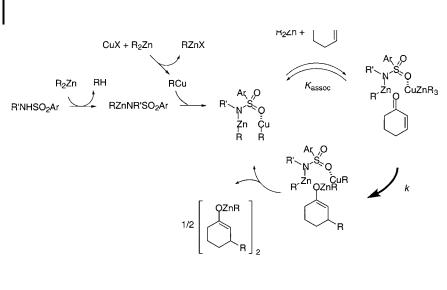
322 10 Mechanisms of Copper-mediated Addition and Substitution Reactions
Fig. 10.1. Proposed catalytic cycle of copper-catalyzed conjugate addition.
10.2.4
Catalytic Conjugate Addition
There are a large number of reports on copper(I)-catalyzed conjugate additions, yet there is only scant information available about their reaction mechanisms. Recently, the conjugate addition of organozinc compounds to enones was found by Kitamura, Noyori, et al. to be catalyzed by N-benzylbenzenesulfonamide and CuCN, and the mechanism was scrutinized (Fig. 10.1). The kinetic rate was found to be first order in the concentrations of the catalyst that exist in equilibrium with R2Zn and enone [77].
In the enantioselective copper(I)-catalyzed conjugate addition of a cyclic enone with a chiral ligand, the observed nonlinear e ects indicate that Cu(I) aggregates participate in the reaction [78].
10.2.5
Theoretically Based Conjugate Addition Reaction Pathway
The reaction pathways of conjugate addition of Me2CuLi and Me2CuLi LiCl have been studied for acrolein [79] and cyclohexenone [80] with the aid of density functional methods, and fit favorably with the 13C NMR properties of intermediates, kinetic isotope e ects [81], and the diastereofacial selectivity. A similar mechanism also operates in this reaction, as summarized in Scheme 10.5. The rate-determining step of the reaction (TScc) is the CaC bond formation caused by reductive elimination from CuIII to give CuI.
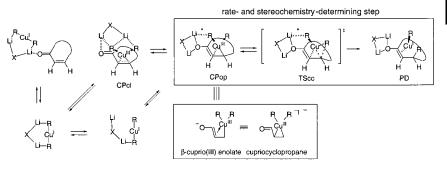
10.2 Conjugate Addition Reaction 323
Scheme 10.5. Plausible pathway of conjugate addition of (R2CuLi)2 to enones. Solvent molecules are omitted for clarity. The lithium atoms are fully solvated and the RaLi association indicated with a broken line (*) in
CPop and TScc may be extremely small or nonexistent in solution. Here, in Schemes 10.7, 10.9, and 10.10, and in Fig. 10.5, the X group can be RCuR, halogen, etc.
TScc is also the stage at which the enantiofacial selectivity of the reaction is determined [80]. This conflicts with the conventional assumption that the face selectivity is established in the initial p-complexation [40a], which is now shown to represent a preequilibrium state preceding TScc. The calculated activation energy taking the solvation of the lithium atoms into account shows reasonable agreement with recently determined experimental data [75].
The central feature of the mechanism is the 3-cuprio(III) enolate Cpop, of an open, dimeric nature, as shown by comparison of theory with experimentation involving 13C NMR and KIEs [80, 81]. This species serves as the direct precursor to the product (Scheme 10.5, top box). In this critical CPop complex, copper/olefin (soft/soft) and a lithium/carbonyl (hard/hard) interactions are present. The open complex may be formed directly, by way of an open cluster (bottom left of Scheme 10.5), or by complexation of a closed cluster with the enone (CPcl). Experiments have shown that the enone/lithium complex (top left of Scheme 10.11) is a deadend species [60, 74].
The CPop intermediate is the ‘‘b-cuprio ketone’’ intermediate widely debated in mechanistic discussions of conjugate addition (cf. Scheme 10.3). On the basis of recent theoretical analysis, two limiting structures for CPop may now be considered; these are shown in the bottom box in Scheme 10.5. The reason for the exceptional stability of CPop as a trialkylcopper(III) species can be readily understood in terms of the ‘‘b-cuprio(III) enolate’’ structure, with the internal enolate anion acting as a strong stabilizing ligand for the CuIII state [82].
In spite of the apparent di erence between conjugate addition and carbocupration reactions (Sect. 10.3.2), the similarities between the key organometallic features of the two reactions are now evident. In both reactions, inner sphere electrontransfer converts the stable CaCuI bond into an unstable CaCuIII bond, and the cluster-opening generates a nucleophilic, tetracoordinated alkyl group. The di erence is that the product of conjugate addition (PD) remains as a lithium enolate complexed with RCuI (Scheme 10.5), while the initial product of carbocupration
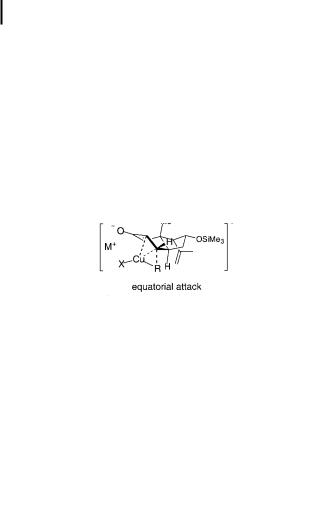
324 10 Mechanisms of Copper-mediated Addition and Substitution Reactions
(INT2, Scheme 10.7) undergoes further reaction (Li/Cu transmetalation) and generates a new organocuprate compound. (Note however that this di erence could become more subtle since the product of conjugate addition (PD) might behave more like an a-cuprio(I) ketone complexed with a lithium cation [52] than a lithium enolate complexed with copper(I)). In neither reaction was any evidence of radical intermediates (i.e., SET) found by theoretical calculations [79].
Synthetic chemists can now work with three-dimensional pictures of the conjugate addition available on a website [80]. In the absence of steric hindrance (5-methylcyclohexenone, for example), an ‘‘axial attack’’ through a half-chair conformation is favored, while in the cortisone synthesis an ‘‘equatorial attack’’ through a half-boat conformation is favored because of the constraint imposed by the bicyclic rings [83].
Scheme 10.6. Transition states for diastereoselective conjugate additions. In solution, the lithium and M cations must be fully solvated with solvent molecules. The MeaLi association (indicated with an asterisk) will be extremely weak or nonexistent in solution.
10.3
Carbocupration Reactions of Acetylenes and Olefins
10.3.1
Experimental Facts
The carbocupration of acetylene takes place smoothly in a cis fashion, providing a reliable synthetic route to vinyl copper species (Eq. 10.8) [24]. Magnesium and zinc,
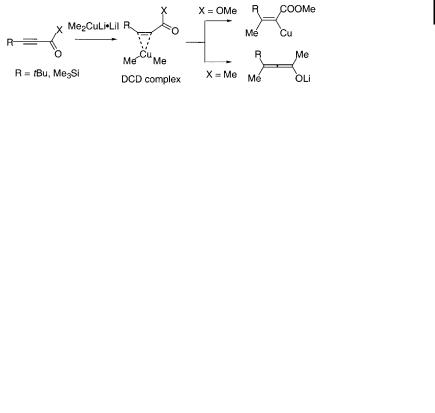
10.3 Carbocupration Reactions of Acetylenes and Olefins 325
which are more Lewis acidic than lithium, are better counter-cations for this reaction, and strong coordination of a lithium dialkylcuprate(I) with a crown ether dramatically slows down the reaction [84]. This reaction used to be generally considered to proceed through a four-centered mechanism, and hence to be mechanistically di erent from conjugate addition.
ð10:8Þ
In the addition of Me2CuLi reagents to electron-deficient acetylenes [85–88], DCDtype complexes have been identified by NMR [84, 89]. As shown below, an ynoate a ords a vinylcopper intermediate, while an ynone instead a ords an allenolate (Eq. 10.9). The origin of this diversity remains unclear. A related carbocupration mechanism has also been proposed for the reaction with allenylphosphine oxide [53]. Olefin carbocupration of dienes [90] and cyclopropenes [34, 36] is known, but these mechanisms also remain unclear.
ð10:9Þ
10.3.2
Theoretically Based Carbocupration Reaction Pathway
The carbocupration of acetylene has been studied systematically for five model species – MeCu, Me2Cu , Me2CuLi, Me2CuLi LiCl, and (Me2CuLi)2 [91] – all of which have been invoked once in a while in discussions of cuprate mechanisms. A few general conclusions have been made regarding the reactivities of these reagents with p-acceptors:
(1)The copper d-orbital being very low-lying (hence no redox chemistry available) [92], MeCu can undergo addition only through a four-centered mechanism (Eq. 10.8).
(2)This four-centered pathway requires a large amount of energy, since the covalent MeaCu bond (55 kcal mol 1 [93]) must be cleaved. A neutral RCu species is therefore not a reactive nucleophile.
(3)Being electron-rich (thus with high-lying d-orbitals), lithium cuprates such as (R2CuLi)2 bind tightly to acetylene through two-electron donation from a copper atom (cf. CP in Scheme 10.7). In such complex formation, a cluster structure certainly larger than the parent species R2CuLi is necessary to achieve cooperation of lithium and copper.
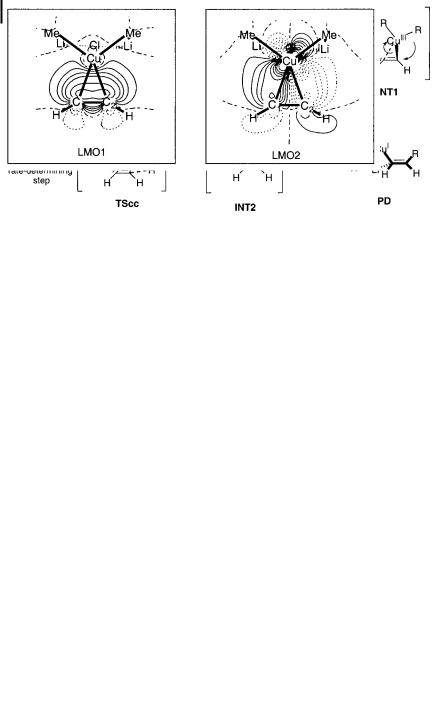
326 10 Mechanisms of Copper-mediated Addition and Substitution Reactions
Scheme 10.7. Trap-and-bite pathway of carbocupration.
The reaction pathway may be viewed as a ‘‘trap-and-bite’’ mechanism; the structures involved are shown in Scheme 10.7. The cluster opens up and traps the acetylene (INT1), transfers electrons, and then ‘‘bites’’ the substrate to form a CaC bond (TScc). The important events include formation of a DCD-complex (CP) via a low energy TS (TScp) [94], inner-sphere electron transfer to form a transient intermediate INT1, CaC bond formation through the rate-determining stage TScc, and intra-cluster transmetalation from lithium to copper(I) (INT2). The DCD character of CP is shown by the localized molecular orbitals (LMOs, Fig. 10.2), and has also been found in conjugate addition reactions to enals and enones [79]. Since the CaCuIII bond is very unstable, the activation energy for CaC bond formation via TScc becomes small (<20 kcal mol 1). In solution, the reaction may go directly to INT1, or to related species through an open cluster.
It should be noted that the depictions of the ‘‘organic’’ arrows and the indications of the valence of the metal as in Scheme 10.7 (and others in the following para-
Fig. 10.2. Localized molecular orbitals of the complex (CP) between Me2CuLi LiCl and acetylene.

10.4 Substitution Reactions on Carbon Atoms 327
Fig. 10.3. ‘‘Snapshots’’ of intermediates on the potential energy surface of carbocupration of acetylene.
graphs) are necessarily inaccurate from a purely inorganic or theoretical viewpoint. We have nonetheless indicated them, to put the theoretical results into the context of conventional organic chemistry, and to facilitate understanding of the chemistry by organic chemists using the reagents in everyday research.
Figure 10.3 shows ‘‘snapshots’’ of intermediary species on the potential surface of carbocupration to illustrate the transformation of the reacting complex. The formation of the transient carbolithiated intermediate INT2 is the most striking feature, because recognition of this intermediate provides the key to understanding of the kinship of carbocupration, SN20 allylation (Sect. 10.4.2), and conjugate addition.
10.4
Substitution Reactions on Carbon Atoms
10.4.1
SN2 Mechanism of Stoichiometric Substitution Reactions
SN2 substitution reactions of alkyl halides with hard nucleophiles such as alkyl anions can be achieved most readily with the aid of organocopper chemistry [95]. SN2 reactions with epoxides and aziridines are also synthetically useful [96]. The
